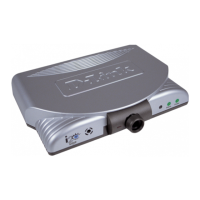
Do you have a question about the D-Link i2eye DVC-1000 and is the answer not in the manual?
Details the layout and functions of the remote control for device operation.
Explains the initial screen of the setup wizard and how to navigate.
Details how to enter personal information like name, country, and phone number.
Covers obtaining IP address, subnet mask, and gateway for network connection.
Explains how to configure primary and secondary DNS server addresses.
Allows selection of connection type and setting of send/receive speeds.
Details the system restart required to finalize the setup wizard.
Explains how to answer incoming video calls using the handset or remote.
Details how to place calls using the telephone handset for speed dial or manual dialing.
Guides on how to place calls using the remote control via manual dialing.
Explains how to initiate a call using the speed dial list with the remote.
Instructions for making local video calls using matching country and area codes.
How to make long-distance video calls with a different area code.
How to make international video calls with a different country code.
How to place video calls by directly entering the IP address of the device.
Covers obtaining IP address, subnet mask, and gateway for network connection.
Explains how to configure primary and secondary DNS server addresses.
Manages how the public IP address is obtained or specified.
Allows setting transmit and receive speeds for optimal connection.
Specific configuration steps for D-Link routers.
Explains the need to open specific ports for router/firewall access.
Step-by-step guide to opening necessary ports on a router.
Troubleshooting steps for issues with making calls via phone numbers.
Troubleshooting steps for issues with making direct IP calls.
Addresses problems where the VideoPhone freezes while answering calls.
Solutions for poor video quality, including focus and motion issues.
Steps to resolve issues where no video is displayed during a call.
Solutions for video freezing during an ongoing call due to network congestion.
Steps to resolve issues where no audio is transmitted or received.
Addresses audio stopping mid-call due to muting or network congestion.
How to fix conversation delay by adjusting network speeds.
Resolves errors related to the update server, internet connection, or firewall.
Addresses errors indicating the VideoPhone cannot obtain a public IP address.
Resolves errors when the VideoPhone fails to register with the Directory Service.
Fixes issues with not connecting to a DHCP server or accessing IP addresses.
Addresses packet loss issues due to network congestion or incorrect speeds.
Resolves issues related to Ethernet connection, DNS entries, or IP/subnet/gateway settings.
Solutions for when the Public IP button is not enabled, possibly due to IP detection delays.
Adjusts network speeds to fix performance issues like packet loss.
Addresses issues with the VideoPhone not booting up, power, or display.